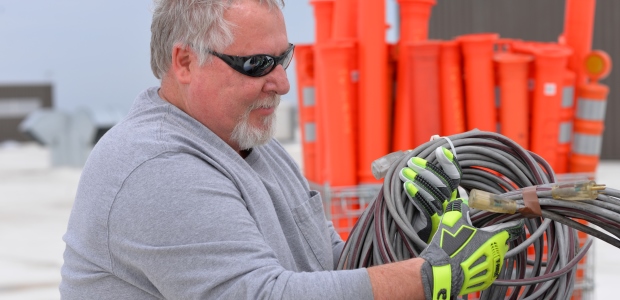
Helping Hands Keep Their Cool
As new technology and ideas develop, you’ll begin to see many different combinations as customers think about what works best for their applications and ask for it in the marketplace.
- By M.B. Sutherland
- Jun 01, 2018
By now, we all know the statistics that tell us the primary reason workers remove their gloves is discomfort. And while this is a year-round "indoor" problem, the summer months and the heat that comes with them become another obstacle to keeping people protected. Trapped heat, sweaty skin, and contact dermatitis are all side effects of keeping traditional gloves on hard working hands.
Three Keys to Cooler Hands
Workers are driven to take their gloves off to air and cool their hands and to let some of the moisture that's been trapped inside their gloves evaporate. But what if we could design hand protection that lets those things happen continuously, without removing the gloves?
Three significant factors for heat relief are:
- Air permeability,
- Sensory cooling, and
- Moisture management.
Air Permeability
Air permeability is a measure of how easily air passes through a material. For example, mesh is very porous with high air permeability and leather is a denser material with low air permeability. So while we know workers love their leather drivers, this is a glove you'll often see coming off for relief between tasks. And once the glove is off, it's easy for workers to leave that glove off and work unprotected.
For years, safety clothing manufacturers have been using thicker material for areas that need protection while employing mesh material for areas that are not at risk, to make a cooler overall garment. A good example is a welding jacket with a traditional heat-resistant front paired with a mesh back to allow air to flow around the worker's skin and let heat escape.
Manufacturers have adopted this concept for air flow within gloves. This takes different forms, depending on the type of glove:
- Cut-resistant work gloves. Air-permeable work gloves can now be made with traditional palm materials such as leather with a cut-resistant liner, but with the addition of a mesh back to create a cooler glove with protection where it's needed.
- Impact-resistant gloves. For impact-resistant gloves, air-permeable designs can include vented material underneath the TPR on the back of the hand, as well as venting in the TPR itself. This provides the same protection from impacts, while allowing air to flow into the glove to keep hands cooler.
Custom glove manufacturers can often make whatever combination of these features you may need—for example, an impact glove with a cut-resistant-lined leather palm, cut-resistant mesh back, and vented TPR. So as new technology and ideas develop, you'll begin to see many different combinations as customers think about what works best for their applications and ask for it in the marketplace.
Sensory Cooling
Sensory cooling is the ability of some fibers to induce a sensation of coolness on the skin. These fibers trigger cold receptors in the nerve endings near skin’s surface, making the wearer more comfortable just by coming into contact with it.
Think of the sensation of flipping your pillow over to the cool side in the middle of the night, but in a glove! One such cooling fabric is High Performance Polyethylene (HPPE), which is a lightweight alternative to heavier cut-resistant fabrics such as Aramid. Depending on the manufacturing process used, HPPE can provide higher cut protection in a glove that’s considerably cooler.
Moisture Management
Sweaty hands inside a glove are a particularly difficult comfort problem because sweaty skin is more prone to irritation. Unfortunately, the most obvious way to get relief is exactly what you don't want workers to do—remove the gloves.
Manufacturers are combating this problem with moisture-wicking fibers that accelerate moisture evaporation. One of the most common of these is modified polyester. Fabrics made with this special fiber, particularly when used in higher gauge gloves, are very effective at drawing moisture away from the skin. Though modified polyester itself has better air permeability than many other fibers, combining it with an air-permeable construction like mesh is even more efficient at speeding sweat evaporation to keep hands dryer, cooler, and more comfortable even in hot conditions.
Another way to keep hands cool is to choose gloves that are made using coreless technology. Traditional cut-resistant yarn is made of an inner core, usually made of fiberglass, steel, basalt, or some combination of the three. This core is wrapped in cut-resistant fibers such as HPPE or Aramid, along with additional fillers such as nylon, polyester, or spandex. Revolutionary new coreless technology eliminates the core by infusing yarn with strength-enhancing micro particles to create cut resistance that’s inherent to the yarn itself. This creates a glove that's up to 20 percent lighter, cooler, and much more comfortable in hot environments.
Could Your Solution Already Be Out There?
We all have our favorite gloves and materials and it's easy to stick with what we know. But more manufacturers are paying attention to cooling construction and technologies to help keep workers protected.
As better and more varied combinations of features hit the market, it's a good bet that there's a cooler glove alternative for a job you're doing. It's possible the problem you're struggling with may already be solved!
This article originally appeared in the June 2018 issue of Occupational Health & Safety.